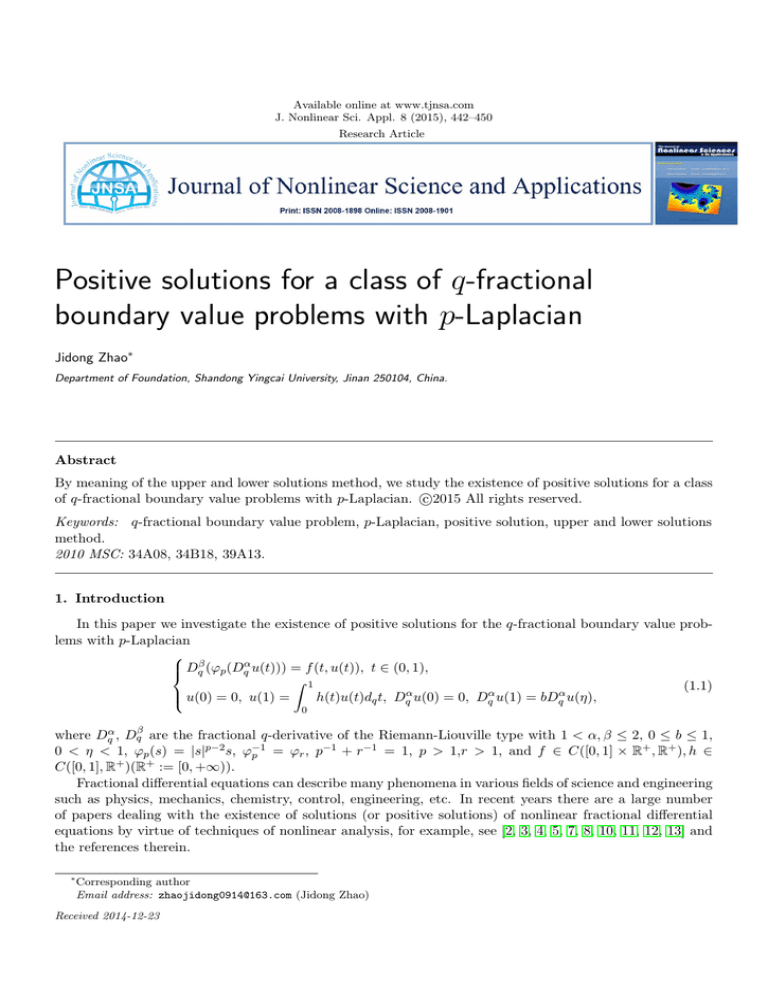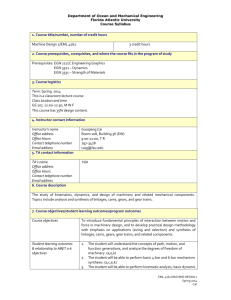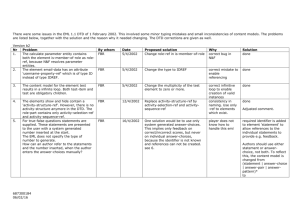
Available online at www.tjnsa.com
J. Nonlinear Sci. Appl. 8 (2015), 442–450
Research Article
Positive solutions for a class of q-fractional
boundary value problems with p-Laplacian
Jidong Zhao∗
Department of Foundation, Shandong Yingcai University, Jinan 250104, China.
Abstract
By meaning of the upper and lower solutions method, we study the existence of positive solutions for a class
c
of q-fractional boundary value problems with p-Laplacian. 2015
All rights reserved.
Keywords: q-fractional boundary value problem, p-Laplacian, positive solution, upper and lower solutions
method.
2010 MSC: 34A08, 34B18, 39A13.
1. Introduction
In this paper we investigate the existence of positive solutions for the q-fractional boundary value problems with p-Laplacian
β
α
Dq (ϕp (Dq u(t))) = f (t, u(t)), t ∈ (0, 1),
Z 1
(1.1)
h(t)u(t)dq t, Dqα u(0) = 0, Dqα u(1) = bDqα u(η),
u(0) = 0, u(1) =
0
where Dqα , Dqβ are the fractional q-derivative of the Riemann-Liouville type with 1 < α, β ≤ 2, 0 ≤ b ≤ 1,
0 < η < 1, ϕp (s) = |s|p−2 s, ϕ−1
= ϕr , p−1 + r−1 = 1, p > 1,r > 1, and f ∈ C([0, 1] × R+ , R+ ), h ∈
p
C([0, 1], R+ )(R+ := [0, +∞)).
Fractional differential equations can describe many phenomena in various fields of science and engineering
such as physics, mechanics, chemistry, control, engineering, etc. In recent years there are a large number
of papers dealing with the existence of solutions (or positive solutions) of nonlinear fractional differential
equations by virtue of techniques of nonlinear analysis, for example, see [2, 3, 4, 5, 7, 8, 10, 11, 12, 13] and
the references therein.
∗
Corresponding author
Email address: zhaojidong0914@163.com (Jidong Zhao)
Received 2014-12-23
J. Zhao, J. Nonlinear Sci. Appl. 8 (2015), 442–450
443
In [2], R. Almeida and N. Martins discussed the fractional q-difference equation
C α
Dq [x](t) = g(t, x(t)), 0 ≤ t ≤ 1,
x(0) = γ0 , Dq [x](0) = γ1 ,
Rη
x(1) = γ2 0 x(s)dq s,
(1.2)
and presented some sufficient conditions regarding the existence and uniqueness of solutions for (1.2). Their
arguments are based on fixed point theorems: Banach fixed point theorem, Krasnoselskii fixed point theorem
and Leray-Schauder alternative.
As known to all, the upper and lower solutions method is an effective tool to deal with the existence of
solutions for nonlinear differential equations, see [5, 7, 10, 11, 12]. However, to the best of our knowledge, few
results exist in the literatures devoted to investigate integral boundary conditions by applying the method.
Motivated by the above works, in this paper we apply the upper and lower solutions method as well as the
Schauder fixed point theorem to establish a new existence result of at least one positive solution for (1.1).
2. Preliminaries
Let q ∈ (0, 1) and define
[a]q =
1 − qa
,
1−q
a ∈ R.
The q-analogue of the power function (a − b)n with N0 is
(a − b)0 = 1,
(a − b)n =
n−1
Y
(a − bq k ),
n ∈ N, a, b ∈ R.
k=0
More generally, if α ∈ R, then
(α)
(a − b)
∞
Y
a − bq n
=a
.
a − bq α+n
α
n=0
Note that, if b = 0 then a(α) = aα . The q-gamma function is defined by
(1 − q)(x−1)
,
(1 − q)x−1
Γq (x) =
x ∈ R \ {0, −1, −2, . . .},
and satisfies Γq (x + 1) = [x]Γq (x). The q-derivative of a function f is here defined by
f (x) − f (qx)
,
(1 − q)x
(Dq f )(x) =
(Dq f )(0) = lim (Dq f )(x),
x→0
and q-derivatives of higher order by
(Dq0 f )(x) = f (x)
and
(Dqn f )(x) = Dq (Dqn−1 f )(x),
n ∈ N.
The q-integral of a function f defined in the interval [0, b] is given by
x
Z
f (t)dq t = x(1 − q)
(Iq f )(x) =
0
∞
X
f (xq n )q n ,
x ∈ [0, b].
n=0
If a ∈ [0, b] and f is defined in the interval [0, b], its integral from a to b is defined by
Z
b
Z
Z
f (t)dq t −
f (t)dq t =
a
b
0
a
f (t)dq t.
0
J. Zhao, J. Nonlinear Sci. Appl. 8 (2015), 442–450
444
Similarly as done for derivatives, an operator Iqn can be defined, i.e.,
(Iq0 f )(x) = f (x)
and
(Iqn f )(x) = Iq (Iqn−1 f )(x),
n ∈ N.
The fundamental theorem of calculus applies to these operators Iq and Dq , i.e.,
(Dq Iq f )(x) = f (x),
and if f is continuous at x = 0, then
(Iq Dq f )(x) = f (x) − f (0).
Basic properties of the two operators can be found in the book [6]. We now point out three formulas that
will be used later (i Dq denotes the derivative with respect to variable i)
[a(t − s)](α) = aα (t − s)(α) ,
− s)(α) = [α]q (t − s)(α−1) ,
Z x
Z
x
f (x, t)dq t (x) =
x Dq f (x, t)dq t + f (qx, x).
x Dq
t Dq (t
(2.1)
0
0
We note that if α > 0 and a ≤ b ≤ t, then (t − a)(α) ≥ (t − b)(α) (see [3]). The following definition was
considered first in [1].
Definition 2.1. Let α ≥ 0 and f be a function defined on [0, 1]. The fractional q-integral of the RiemannLiouville type is (Iq0 f )(x) = f (x) and
Z x
1
α
(Iq f )(x) =
(x − qt)(α−1) f (t)dq t, α > 0, x ∈ [0, 1].
Γq (α) 0
Definition 2.2. (see [9]) The fractional q-derivative of the Riemann-Liouville type of order α ≥ 0 is defined
by (Dq0 f )(x) = f (x) and
(Dqα f )(x) = (Dqm Iqm−α f )(x), α > 0,
where m is the smallest integer greater than or equal to α.
Next, we list some properties that are already known in the literature. Its proof can be found in [1, 9].
Lemma 2.3. Let α, β ≥ 0 and f be a function defined on [0, 1]. Then the next formulas hold:
(i) (Iqβ Iqα f )(x) = (Iqα+β f )(x),
(ii) (Dqα Iqα f )(x) = f (x).
Lemma 2.4. (see [3]) Let α > 0 and p be a positive integer. Then the following equality holds:
(Iqα Dqp f )(x)
=
(Dqp Iqα f )(x)
−
p−1
X
k=0
xα−p+k
(Dk f )(0).
Γq (α + k − p + 1) q
Throughout this
we always assume that the following condition holds:
R 1 paperα−1
(H1) κ := 1 − 0 h(t)t
dq t > 0.
Lemma 2.5. Suppose that (H1) holds. Let y ∈ C[0, 1] and 1 < α ≤ 2. Then
α
Dq u(t) + y(t) = 0, t ∈ (0, 1),
Z 1
h(t)u(t)dq t,
u(0) = 0, u(1) =
0
(2.2)
J. Zhao, J. Nonlinear Sci. Appl. 8 (2015), 442–450
445
is equivalent to
Z
1
G(t, qs)y(s)dq s,
u(t) =
0
where
Z
tα−1 1
G(t, s) = g(t, s) +
h(t)g(t, s)dq t,
κ 0
(
(t(1 − s))(α−1) − (t − s)(α−1) ,
1
g(t, s) =
Γq (α) (t(1 − s))(α−1) ,
0 ≤ s ≤ t ≤ 1,
0 ≤ t ≤ s ≤ 1.
Proof. By Lemma 2.4 we have
u(t) = −Iqα y(t) + c1 tα−1 + c2 tα−2 , c1 , c2 ∈ R.
From u(0) = 0 we obtain c2 = 0. Consequently,
u(t) = −Iqα y(t) + c1 tα−1 = −
t
Z
(t − qs)(α−1)
y(s)dq s + c1 tα−1 .
Γq (α)
0
Hence u(1) =
R1
0
h(t)u(t)dq t implies that
Z
c1 =
1
Z
0
and
1
h(t)u(t)dq t +
0
(1 − qs)(α−1)
y(s)dq s,
Γq (α)
Z 1
Z 1
(t − qs)(α−1)
(1 − qs)(α−1)
α−1
α−1
u(t) = −
y(s)dq s + t
y(s)dq s + t
h(t)u(t)dq t
Γq (α)
Γq (α)
0
0
0
Z 1
Z 1
α−1
h(t)u(t)dq t.
=
g(t, qs)y(s)dq s + t
Z
t
(2.3)
0
0
Multiplying h(t) on both sides of (2.3) and integrating over [0, 1], we find
Z
1
1
Z
h(t)u(t)dq t =
Z
h(t)
0
0
1
1
Z
h(t)tα−1 dq t
g(t, qs)y(s)dq sdq t +
0
0
Z
1
h(t)u(t)dq t.
0
By (H1) we have
1
Z
0
1
h(t)u(t)dq t =
κ
Z
1
1
Z
h(t)
g(t, qs)y(s)dq sdq t.
0
0
Combining this with (2.3) we obtain
Z
1
u(t) =
0
Z
=
tα−1
g(t, qs)y(s)dq s +
κ
Z
1
Z
h(t)
0
1
g(t, qs)y(s)dq sdq t
0
1
G(t, qs)y(s)dq s.
0
This completes the proof.
Lemma 2.6. Suppose that (H1) holds. Let y ∈ C[0, 1], 1 < α, β ≤ 2, 0 ≤ b ≤ 1, 0 < η < 1. Then
β
α
Dq (ϕp (Dq u(t))) = y(t), t ∈ (0, 1),
Z 1
u(0)
=
0,
u(1)
=
h(t)u(t)dq t, Dqα u(0) = 0, Dqα u(1) = bDqα u(η),
0
(2.4)
J. Zhao, J. Nonlinear Sci. Appl. 8 (2015), 442–450
446
is equivalent to
1
Z
H(s, qτ )y(τ )dq τ
where
H(t, s) = m(t, s) +
dq s,
0
0
1
m(t, s) =
Γq (β)
1
Z
G(t, qs)ϕr
u(t) =
bp−1 tβ−1
m(η, s),
1 − bp−1 η β−1
(
(t(1 − s))(β−1) − (t − s)(β−1) ,
(t(1 − s))(β−1) ,
0 ≤ s ≤ t ≤ 1,
0 ≤ t ≤ s ≤ 1.
Proof. By Lemma 2.4 we have
ϕp (Dqα u(t)) = Iqβ y(t) + c3 tβ−1 + c4 tβ−2 , c3 , c4 ∈ R.
From Dqα u(0) = 0 we obtain c4 = 0. Consequently,
t
Z
ϕp (Dqα u(t)) = Iqβ y(t) + c3 tβ−1 =
0
(t − qs)(β−1)
y(s)dq s + c3 tβ−1 .
Γq (β)
By (2.4) we obtain
ϕp (Dqα u(1))
Z
1
(1 − qs)(β−1)
y(s)dq s + c3 ,
Γq (β)
η
(η − qs)(β−1)
y(s)dq s + c3 η β−1 ,
Γq (β)
=
0
ϕp (Dqα u(η)) =
Z
0
and
Z
1
0
(1 − qs)(β−1)
y(s)dq s + c3 = bp−1
Γq (β)
Hence
p−1
Z
c3 = b
0
η
Z
0
η
(η − qs)(β−1)
y(s)dq s + c3 bp−1 η β−1 .
Γq (β)
(η − qs)(β−1)
y(s)dq s −
(1 − bp−1 η β−1 )Γq (β)
Z
0
1
(1 − qs)(β−1)
y(s)dq s.
(1 − bp−1 η β−1 )Γq (β)
As a result,
t
Z 1
(t − qs)(β−1)
(1 − qs)(β−1)
y(s)dq s
y(s)dq s − tβ−1
p−1 η β−1 )Γ (β)
Γq (β)
q
0
0 (1 − b
Z η
(η − qs)(β−1)
+ tβ−1 bp−1
y(s)dq s
p−1 η β−1 )Γ (β)
q
0 (1 − b
Z t
Z 1
Z 1
(t − qs)(β−1)
(t(1 − qs))(β−1)
(t(1 − qs))(β−1)
=
y(s)dq s −
y(s)dq s +
y(s)dq s
Γq (β)
Γq (β)
Γq (β)
0
0
0
Z 1
Z η
(t(1 − qs))(β−1)
(η − qs)(β−1)
β−1 p−1
−
y(s)d
s
+
t
b
y(s)dq s
q
p−1 η β−1 )Γ (β)
p−1 η β−1 )Γ (β)
q
q
0 (1 − b
0 (1 − b
Z 1
Z 1
bp−1 tβ−1
=−
m(t, qs)y(s)dq s −
m(η, qs)y(s)dq s
1 − bp−1 η β−1 0
0
Z 1
=−
H(t, qs)y(s)dq s.
ϕp (Dqα u(t)) =
Z
0
Consequently,
Z
α
Dq u(t) + ϕr
1
H(t, qs)y(s)dq s
0
u(0) = 0, u(1) =
Z
1
h(t)u(t)dq t.
0
= 0,
J. Zhao, J. Nonlinear Sci. Appl. 8 (2015), 442–450
447
Combining this with Lemma 2.5, we have
Z
Z 1
G(t, qs)ϕr
u(t) =
1
H(s, qτ )y(τ )dq τ
dq s.
0
0
This completes the proof.
Lemma 2.7. G(t, s) and H(t, s) defined above have the following properties:
(i) G, H are continuous on [0, 1] × [0, 1] and G(t, qs) ≥ 0, H(t, qs) ≥ 0 for all t, s ∈ [0, 1],
(ii) for any t, s ∈ [0, 1],
σ1 (qs)tα−1 ≤ G(t, qs) ≤ σ2 (qs)tα−1 ,
where
1
σ1 (qs) =
κ
Z
0
1
1
h(t)g(t, qs)dq t, σ2 (qs) =
κ
Z
1
h(t)g(t, qs)dq t +
0
(1 − qs)(α−1)
.
Γq (α)
Lemma 2.8. (see [11, Lemma 2.8]) Let u ∈ C[0, 1] satisfy u(0) = 0, u(1) = ϕp (b)u(η) and Dqβ u(t) ≥ 0 for
all t ∈ (0, 1). Then u(t) ≤ 0 for t ∈ [0, 1].
Let E := {u|u, ϕp (Dqα u) ∈ C 2 [0, 1]}. Now we introduce the following definitions about the upper and
lower solutions for (1.1).
Definition 2.9. A function φ is called a lower solution for (1.1), if φ ∈ E satisfies
β
α
Dq (ϕp (Dq φ(t))) ≤ f (t, φ(t)), t ∈ (0, 1),
Z 1
φ(0)
≤
0,
φ(1)
≤
h(t)φ(t)dq t, Dqα φ(0) ≥ 0, Dqα φ(1) ≥ bDqα φ(η).
0
Definition 2.10. A function ψ is called an upper solution for (1.1), if ψ ∈ E satisfies
β
α
Dq (ϕp (Dq ψ(t))) ≥ f (t, ψ(t)), t ∈ (0, 1),
Z 1
h(t)ψ(t)dq t, Dqα ψ(0) ≤ 0, Dqα ψ(1) ≤ bDqα ψ(η).
ψ(0) ≥ 0, ψ(1) ≥
0
Define A : E → E
Z
(Au)(t) =
1
Z
G(t, qs)ϕr
0
1
H(s, qτ )f (τ, u(τ ))dq τ
dq s.
0
Then, by Lemma 2.6 we obtain that the existence of solutions for (1.1) is equivalent to the existence of fixed
points for the operator A. Furthermore, the continuity G, H and f enables us to prove A is a completely
continuous operator.
3. Main results
Theorem 3.1. Suppose that (H1) and the following conditions hold:
(H2) f ∈ C([0, 1] × [0, +∞), (0, +∞)) and f (t, u) is increasing in u,
(H3) there exists c ∈ (0, 1) such that
f (t, µu) ≥ µc(p−1) f (t, u), ∀µ ∈ [0, 1], t ∈ [0, 1], where p > 1.
Then (1.1) has at least one positive solution.
J. Zhao, J. Nonlinear Sci. Appl. 8 (2015), 442–450
448
Proof. We divide four steps.
Step 1. If u is a positive solution for (1.1), then there exist m1 , m2 > 0 such that
m1 ρ(t) ≤ u(t) ≤ m2 ρ(t),
where
1
Z
1
Z
H(s, qτ )dq τ
G(t, qs)ϕr
ρ(t) =
(3.1)
dq s.
0
0
Indeed, u ∈ C[0, 1] implies that there exists M > 0 such that
|u(t)| ≤ M, ∀t ∈ [0, 1].
By (H2) we can choose
m1 :=
min
p
f (t, u(t)) > 0,
p−1
m2 :=
t∈[0,1],u∈[0,M ]
Then
1
Z
m1 ρ(t) ≤ u(t) = (Au)(t) =
Z
max
p
f (t, u(t)) > 0.
p−1
t∈[0,1],u∈[0,M ]
1
H(s, qτ )f (τ, u(τ ))dq τ
G(t, qs)ϕr
dq s ≤ m2 ρ(t).
0
0
Step 2. The existence of upper and lower solutions for (1.1).
Let
Z 1
Z 1
ξ(t) =
G(t, qs)ϕr
H(s, qτ )f (τ, ρ(τ ))dq τ dq s.
0
0
Then by Lemma 2.6 we obtain ξ is a positive solution for the problem
β
α
Dq (ϕp (Dq u(t))) = f (t, ρ(t)), t ∈ (0, 1),
Z 1
h(t)u(t)dq t, Dqα u(0) = 0, Dqα u(1) = bDqα u(η).
u(0) = 0, u(1) =
(3.2)
0
Furthermore,
1
Z
h(t)ξ(t)dq t, Dqα ξ(0) = 0, Dqα ξ(1) = bDqα ξ(η).
ξ(0) = 0, ξ(1) =
0
By Step 1 we obtain there exist κ1 > 0, κ2 > 0 such that
κ1 ρ(t) ≤ ξ(t) ≤ κ2 ρ(t).
Let ξ1 (t) = δ1 ξ(t), ξ2 (t) = δ2 ξ(t), where
0 < δ1 < min
c
1 1−c
, κ1
κ2
Then
f (t, ξ1 (t)) = f (t, δ1 ξ(t)) = f
, δ2 > max
c
1 1−c
, κ2
κ1
.
ξ(t)
ξ(t) c(p−1)
t, δ1
ρ(t) ≥ δ1
f (t, ρ(t))
ρ(t)
ρ(t)
≥ (δ1 κ1 )c(p−1) f (t, ρ(t)) ≥ δ1p−1 f (t, ρ(t)),
and
Dqβ (ϕp (Dqα ξ1 (t))) = Dqβ (ϕp (Dqα δ1 ξ(t))) = δ1p−1 Dqβ (ϕp (Dqα ξ(t))) = δ1p−1 f (t, ρ(t)) ≤ f (t, ξ1 (t)).
Moreover, from (3.3) we have
Z
ξ1 (0) = 0, ξ1 (1) =
0
1
h(t)ξ1 (t)dq t, Dqα ξ1 (0) = 0, Dqα ξ1 (1) = bDqα ξ1 (η).
(3.3)
J. Zhao, J. Nonlinear Sci. Appl. 8 (2015), 442–450
449
Therefore, by Definition 2.9 we obtain ξ1 is a lower solution for (1.1).
On the other hand,
δ2p−1 f (t, ρ(t))
ρ(t)
ρ(t)
ρ(t) c(p−1)
p−1
p−1
=
t,
ξ2 (t) = δ2 f t,
ξ2 (t) ≥ δ2
f (t, ξ2 (t))
ξ2 (t)
δ2 ξ(t)
δ2 ξ(t)
c(p−1)
1
−(p−1)
p−1
≥ δ2
f (t, ξ2 (t)) ≥ δ2p−1 δ2
f (t, ξ2 (t)) = f (t, ξ2 (t)),
δ2 κ2
δ2p−1 f
and
Dqβ (ϕp (Dqα ξ2 (t))) = Dqβ (ϕp (Dqα δ2 ξ(t))) = δ2p−1 Dqβ (ϕp (Dqα ξ(t))) = δ2p−1 f (t, ρ(t)) ≥ f (t, ξ2 (t)).
Moreover, from (3.3) we have
1
Z
h(t)ξ2 (t)dq t, Dqα ξ2 (0) = 0, Dqα ξ2 (1) = bDqα ξ2 (η).
ξ2 (0) = 0, ξ2 (1) =
0
Therefore, by Definition 2.10 we obtain ξ2 is an upper solution for (1.1).
Step 3. We prove that the following problem has at least one positive solution:
β
α
Dq (ϕp (Dq u(t))) = g(t, u(t)), t ∈ (0, 1),
Z 1
h(t)u(t)dq t, Dqα u(0) = 0, Dqα u(1) = bDqα u(η),
u(0) = 0, u(1) =
(3.4)
0
where
f (t, ξ1 (t)), u(t) < ξ1 (t),
g(t, u(t)) = f (t, u(t)), ξ1 (t) ≤ u(t) ≤ ξ2 (t),
f (t, ξ2 (t)), u(t) > ξ2 (t).
To see this, we consider the operator B : C[0, 1] → C[0, 1]
Z 1
Z 1
(Bu)(t) =
G(t, qs)ϕr
H(s, qτ )g(τ, u(τ ))dq τ dq s.
0
0
By [11, Page 10 and 11], we obtain B is a compact operator, by using the Schauder fixed point theorem,
the operator B has at least a fixed point, i.e., (3.4) has at least one positive solution.
Step 4. We prove (1.1) has at least one positive solution. Suppose that u∗ is a positive solution for
(3.4), according to Step 3 we only need to prove
ξ1 (t) ≤ u∗ (t) ≤ ξ2 (t) for t ∈ [0, 1].
The method is similar for the two inequalities. We only prove u∗ (t) ≤ ξ2 (t) for t ∈ [0, 1]. Suppose by
contradiction that u∗ (t) > ξ2 (t). From (3.4) we have
Dqβ (ϕp (Dqα u∗ (t))) = g(t, u∗ (t)) = f (t, ξ2 (t)).
On the other hand, since ξ2 is an upper solution for (1.1), we have
Dqβ (ϕp (Dqα ξ2 (t))) ≥ f (t, ξ2 (t)).
Let z(t) = ϕp (Dqα ξ2 (t)) − ϕp (Dqα u∗ (t)). Then
Dqβ z(t) = Dqβ (ϕp (Dqα ξ2 (t))) − Dqβ (ϕp (Dqα u∗ (t))) ≥ f (t, ξ2 (t)) − f (t, ξ2 (t)) = 0,
z(0) = 0, z(1) = ϕp (b)z(η).
J. Zhao, J. Nonlinear Sci. Appl. 8 (2015), 442–450
450
Thus by Lemma 2.8 we have z(t) ≤ 0, t ∈ [0, 1], which implies that
ϕp (Dqα ξ2 (t)) ≤ ϕp (Dqα u∗ (t)), t ∈ [0, 1].
Since ϕp is monotone increasing, we obtain Dqα ξ2 (t) ≤ Dqα u∗ (t), i.e., Dqα (ξ2 − u∗ )(t) ≤ 0. Combining Lemma
2.5, we have (ξ2 − u∗ )(t) ≥ 0. Therefore, ξ2 (t) ≥ u∗ (t), t ∈ [0, 1], a contradiction to the assumption that
u∗ (t) > ξ2 (t).
Consequently, ξ1 (t) ≤ u∗ (t) ≤ ξ2 (t) for t ∈ [0, 1], i.e., u∗ is a positive solution for (1.1). This completes
the proof.
Remark 3.2. In [7], the authors had the following condition:
(Hf ) f (t, u) ∈ C([0, 1] × [0, +∞), (0, +∞)) is nondecreasing relative to u and there exists a positive
constant c < 1 such that
µc f (t, u) ≤ f (t, µu), ∀0 ≤ µ ≤ 1.
Moreover, their example is f (t, u) = t+uc , 0 < c < 1. This is a sublinear function. We note that if p ≥ 2, this
example also satisfies our condition (H3). However, if f (t, u) = et + uσ , where σ > 1, u ∈ [0, +∞), t ∈ [0, 1],
then (Hf ) doesn’t hold for all u ∈ [0, +∞), but (H3) still holds with p ≥ σc + 1. In a word, for some
appropriate values of p, our nonlinear term f is allowed to grow superlinearly or sublinearly.
References
[1] R. P. Agarwal, Certain fractional q-integrals and q-derivatives, Proc. Cambridge Philos. Soc., 66 (1969), 365–370.
2, 2
[2] R. Almeida, N. Martins, Existence results for fractional q-difference equations of order α ∈]2, 3[ with three-point
boundary conditions, Commun. Nonlinear Sci. Numer. Simulat., 19 (2014), 1675–1685. 1
[3] R. Ferreira, Nontrivial solutions for fractional q-difference boundary-value problems, Electron, J. Qual. Theory
Differ. Equ., 70 (2010), 10 pages. 1, 2, 2.4
[4] J. Graef, L. Kong, Positive solutions for a class of higher order boundary value problems with fractional qderivatives, Appl. Math. Comput., 218 (2012), 9682–9689. 1
[5] M. Jia, X. Liu, Multiplicity of solutions for integral boundary value problems of fractional differential equations
with upper and lower solutions, Appl. Math. Comput., 232 (2014), 313–323. 1, 1
[6] V. Kac and P. Cheung, Quantum Calculus, Springer, New York, (2002). 2
[7] S. Liang, J. Zhang, Positive solutions for boundary value problems of nonlinear fractional differential equation,
Nonlinear Anal., 71 (2009), 5545–5550. 1, 1, 3.2
[8] F. Miao, S. Liang, Uniqueness of positive solutions for fractional q-difference boundary-value problems with pLaplacian operator, Electron. J. Diff. Equ., 174 (2013), 11 pages. 1
[9] P. Rajković, S. Marinković, M. Stanković, Fractional integrals and derivatives in q-calculus, Appl. Anal. Discrete
Math., 1 (2007), 311–323. 2.2, 2
[10] W. Xie, J. Xiao, Z. Luo, Existence of extremal solutions for nonlinear fractional differential equation with nonlinear
boundary conditions, Appl. Math. Lett., 41 (2015), 46–51. 1, 1
[11] Q. Yuan, W. Yang, Positive solution for q-fractional four-point boundary value problems with p-Laplacian operator,
J. Inequal. Appl., 2014 (2014), 14 pages. 1, 1, 2.8, 3
[12] Y. Zhao, S. Sun, Z. Han, Q. Li, The existence of multiple positive solutions for boundary value problems of
nonlinear fractional differential equations, Commun. Nonlinear Sci. Numer. Simulat. 16 (2011), 2086–2097. 1, 1
[13] X. Zhang, L. Liu, Y. Wu, The uniqueness of positive solution for a fractional order model of turbulent flow in a
porous medium, Appl. Math. Lett., 37 (2014), 26–33. 1







